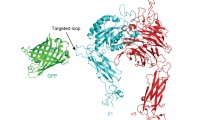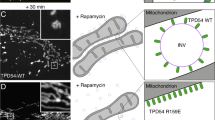Abstract
The role of three membrane proteins in altering the diffusion and clustering of integrin receptors has been measured. Integrins are membrane proteins responsible for integrating intracellular and extracellular signaling events and anchoring cells to the extracellular matrix. The methodology used to elucidate the role of other membrane proteins in altering integrin diffusion and clustering combines fluorescence microscopy with RNA interference (RNAi), which is a technique to reduce the expression of a target protein. The three RNAi-targeted membrane proteins were epidermal growth factor receptor (EGFR), platelet-derived growth factor/vascular endothelial growth factor-related receptor (Pvr), and Notch. Real-time polymerase chain reaction or quantitative immunocytochemistry was used to measure a reduction in mRNA or protein concentration after RNAi treatment, respectively. Fluorescence recovery after photobleaching showed that reducing the concentration of EGFR or Notch results in less constrained integrin diffusion and, in the case of Notch RNAi, 4 % more mobile integrins. Fluorescence resonance energy transfer measurements performed before and after RNAi treatments indicate that clustering decreases for wild-type integrin, but increases for a high-ligand-affinity integrin mutant after reducing the expression of EGFR, Pvr, or Notch. A model to explain the measured changes after reducing the expression of these three membrane proteins involving cholesterol-enriched nanodomains is proposed.

A combination of fluorescence microscopy and RNAi interference were used to measure how selectively reducing the expression of one membrane protein affects clustering and diffusion of another membrane protein





Similar content being viewed by others
References
Kusumi A, Sako Y (1996) Cell surface organization by the membrane skeleton. Curr Opin Cell Biol 8(4):566–574
Dikic I, Bethani I, Skanland SS, Acker-Palmer A (2010) Spatial organization of transmembrane receptor signalling. EMBO J 29(16):2677–2688
Petersen NO (1984) Diffusion and aggregation in biological membranes. Can J Biochem Cell Biol 62(11):1158–1166
Guidotti G (1972) Membrane proteins. Annu Rev Biochem 41:731–752
Giancotti FG, Ruoslahti E (1999) Integrin signaling. Science 285(5430):1028–1032
Qin J, Vinogradova O, Plow EF (2004) Integrin bidirectional signaling: a molecular view. PLoS Biol 2(6):e169
Brown EJ (2002) Integrin-associated proteins. Curr Opin Cell Biol 14(5):603–607
Martin-Bermudo MD (2000) Integrins modulate the Egfr signaling pathway to regulate tendon cell differentiation in the Drosophila embryo. Development 127(12):2607–2615
Duchek P, Somogyi K, Jekely G, Beccari S, Rorth P (2001) Guidance of cell migration by the Drosophila PDGF/VEGF receptor. Cell 107(1):17–26
Llimargas M (1999) The Notch pathway helps to pattern the tips of the Drosophila tracheal branches by selecting cell fates. Development 126(11):2355–2364
Schlessinger J (2000) Cell signaling by receptor tyrosine kinases. Cell 103(2):211–225
Chung J, Soung YH, Clifford JL (2010) Crosstalk between integrin and receptor tyrosine kinase signaling in breast carcinoma progression. BMB Rep 43(5):311–318
Mariotti A, Kedeshian PA, Dans M, Curatola AM, Gagnoux-Palacios L, Giancotti FG (2001) EGF-R signaling through Fyn kinase disrupts the function of integrin alpha6beta4 at hemidesmosomes: role in epithelial cell migration and carcinoma invasion. J Cell Biol 155(3):447–458
Gagnoux-Palacios L, Dans M, van’t Hof W, Mariotti A, Pepe A, Meneguzzi G, Resh MD, Giancotti FG (2003) Compartmentalization of integrin alpha6beta4 signaling in lipid rafts. J Cell Biol 162(7):1189–1196
Baron W, Decker L, Colognato H, Ffrench-Constant C (2003) Regulation of integrin growth factor interactions in oligodendrocytes by lipid raft microdomains. Curr Biol 13(2):151–155
Sieg DJ, Hauck CR, Ilic D, Klingbeil CK, Schaefer E, Damsky CH, Schlaepfer DD (2000) FAK integrates growth-factor and integrin signals to promote cell migration. Nat Cell Biol 2(5):249–256
Campos LS, Decker L, Taylor V, Skarnes W (2006) Notch, epidermal growth factor receptor, and beta1-integrin pathways are coordinated in neural stem cells. J Biol Chem 281(8):5300–5309
Hasson P, Paroush Z (2007) Crosstalk between the EGFR and other signalling pathways at the level of the global transcriptional corepressor Groucho/TLE. Br J Cancer 96(Suppl):R21–R25
Dibya D, Sander S, Smith EA (2009) Identifying cytoplasmic proteins that affect receptor clustering using fluorescence resonance energy transfer and RNA interference. Anal Bioanal Chem 395(7):2303–2311
Sander S, Arora N, Smith EA (2012) Elucidating the role of select cytoplasmic proteins in altering diffusion of integrin receptors. Anal Bioanal Chem 403(8):2327–2337
Hannon GJ (2002) RNA interference. Nature 418(6894):244–251
Milhavet O, Gary DS, Mattson MP (2003) RNA interference in biology and medicine. Pharmacol Rev 55(4):629–648
Brower DL (2003) Platelets with wings: the maturation of Drosophila integrin biology. Curr Opin Cell Biol 15(5):607–613
Bunch TA, Brower DL (1992) Drosophila PS2 integrin mediates RGD-dependent cell–matrix interactions. Development 116(1):239–247
Bunch TA, Helsten TL, Kendall TL, Shirahatti N, Mahadevan D, Shattil SJ, Brower DL (2006) Amino acid changes in Drosophila alphaPS2betaPS integrins that affect ligand affinity. J Biol Chem 281(8):5050–5057
Bunch TA (2010) Integrin alphaIIbbeta3 activation in Chinese hamster ovary cells and platelets increases clustering rather than affinity. J Biol Chem 285(3):1841–1849
Narasimha M, Brown N (2004) Integrins and associated proteins in Drosophila development. Madame Curie Bioscience Database. http://www.ncbi.nlm.nih.gov/books/NBK6575/
Dasgupta R, Perrimon N (2004) Using RNAi to catch Drosophila genes in a web of interactions: insights into cancer research. Oncogene 23(51):8359–8365
Smith EA, Bunch TA, Brower DL (2007) General in vivo assay for the study of integrin cell membrane receptor microclustering. Anal Chem 79(8):3142–3147
Brown NH (1994) Null mutations in the alpha PS2 and beta PS integrin subunit genes have distinct phenotypes. Development 120(5):1221–1231
Boutros M, Kiger AA, Armknecht S, Kerr K, Hild M, Koch B, Haas SA, Paro R, Perrimon N (2004) Genome-wide RNAi analysis of growth and viability in Drosophila cells. Science 303(5659):832–835
Horn T, Sandmann T, Boutros M (2010) Design and evaluation of genome-wide libraries for RNA interference screens. Genome Biol 11(6):R61
Calcagno AM, Chewning KJ, Wu CP, Ambudkar SV (2006) Plasma membrane calcium ATPase (PMCA4): a housekeeper for RT-PCR relative quantification of polytopic membrane proteins. BMC Mol Biol 7:29
Bland JM, Altman DG (1996) Transformations, means, and confidence intervals. BMJ 312(7038):1079
Dibya D, Arora N, Smith EA (2010) Noninvasive measurements of integrin microclustering under altered membrane cholesterol levels. Biophys J 99(3):853–861
Feder TJ, Brust-Mascher I, Slattery JP, Baird B, Webb WW (1996) Constrained diffusion or immobile fraction on cell surfaces: a new interpretation. Biophys J 70(6):2767–2773
Waters JC (2009) Accuracy and precision in quantitative fluorescence microscopy. J Cell Biol 185(7):1135–1148
de Sousa Abreu R, Penalva LO, Marcotte EM, Vogel C (2009) Global signatures of protein and mRNA expression levels. Mol Biosyst 5(12):1512–1526
Maier T, Guell M, Serrano L (2009) Correlation of mRNA and protein in complex biological samples. FEBS Lett 583(24):3966–3973
Yeung ES (2011) Genome-wide correlation between mRNA and protein in a single cell. Angew Chem Int Ed 50(3):583–585
Moghadaszadeh B, Albrechtsen R, Guo LT, Zaik M, Kawaguchi N, Borup RH, Kronqvist P, Schroder HD, Davies KE, Voit T, Nielsen FC, Engvall E, Wewer UM (2003) Compensation for dystrophin-deficiency: ADAM12 overexpression in skeletal muscle results in increased alpha 7 integrin, utrophin and associated glycoproteins. Hum Mol Genet 12(19):2467–2479
Allikian MJ, Hack AA, Mewborn S, Mayer U, McNally EM (2004) Genetic compensation for sarcoglycan loss by integrin alpha7beta1 in muscle. J Cell Sci 117(Pt 17):3821–3830
Saffman PG, Delbruck M (1975) Brownian motion in biological membranes. Proc Natl Acad Sci U S A 72(8):3111–3113
Calderwood DA (2004) Integrin activation. J Cell Sci 117(Pt 5):657–666
Jannuzi AL, Bunch TA, West RF, Brower DL (2004) Identification of integrin beta subunit mutations that alter heterodimer function in situ. Mol Biol Cell 15(8):3829–3840
Pralle A, Keller P, Florin EL, Simons K, Horber JK (2000) Sphingolipid–cholesterol rafts diffuse as small entities in the plasma membrane of mammalian cells. J Cell Biol 148(5):997–1008
Daumas F, Destainville N, Millot C, Lopez A, Dean D, Salome L (2003) Confined diffusion without fences of a G-protein-coupled receptor as revealed by single particle tracking. Biophys J 84(1):356–366
Acknowledgments
This work was supported by the National Science Foundation (CHE-0845236). The authors thank Roger Tsien (Howard Hughes Medical Institute, La Jolla, CA) for the original mCherry plasmid, Atsushi Miyawaki (Riken, Wako-city, Saitama, Japan) for the original Venus plasmid, and Aasim Azad and Andrew Pavel (Iowa State University) for technical assistance. The RT-PCR experiments were performed at the Genomic Technologies Facility in the Center for Plant Genomics at Iowa State University. The monoclonal antibody developed by S. Artavanis Tsakonas (C458-2H) was obtained from the Developmental Studies Hybridoma Bank developed under the auspices of the NICHD and maintained by The University of Iowa, Department of Biology, Iowa City, IA 52242.
Author information
Authors and Affiliations
Corresponding author
Rights and permissions
About this article
Cite this article
Arora, N., Mainali, D. & Smith, E.A. Unraveling the role of membrane proteins Notch, Pvr, and EGFR in altering integrin diffusion and clustering. Anal Bioanal Chem 404, 2339–2348 (2012). https://doi.org/10.1007/s00216-012-6362-3
Received:
Revised:
Accepted:
Published:
Issue Date:
DOI: https://doi.org/10.1007/s00216-012-6362-3




